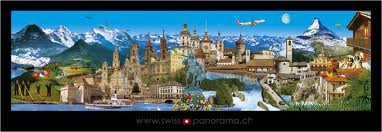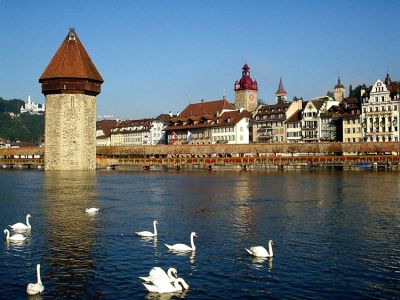
This is a travel experiment that can go horribly wrong. For the first time in my life, I am taking a trip expressly designed for families traveling with children.
As I walk into the lounge of the Hotel Schweizerhof in Lucerne at the cocktail hour to meet my fellow guests for the first time, I do so with a fair bit of trepidation.
I scan the room. Everyone is there and I count 21 children, only one of whom is mine. Reality sets in quickly. My family will be spending an actual vacation without the company of several dozen clients. Instead, I will be in the company of other people and their kids, or grandkids, twenty of them, sharing the sightseeing, the meals, and the bus in a Tauck Bridges Program that encompasses portions of Switzerland, Austria, and a bit of northern Germany. It is a Chevy Chase Vacation Movie with 41 family members.
This trip had to happen. My daughter has been traveling with us since she was four years old. At age ten, she is a Frequent Flyer with three international airlines. Virtually all of her trips have been in the company of our clients. She has never, not once, traveled with kids her own age. We owe her this trip.
But we also owe it to ourselves to experience an important conceptual approach to touring. I have long advocated that the single biggest travel trend of the past decade is the growing tendency of adults traveling abroad with their children. Some postulate that this trend began after the events of September 11 when parents decided that “I will never be separated for weeks at a time from my children again.” I think there is some truth to that. But an even more compelling reason is the growth of high quality family-oriented programs by cruise lines, upscale tour operators, safari companies, and river cruise lines. If you build it well for families – they will come. I think someone at Disney might have once said that.
Companies as diverse as Trafalgar, Abercrombie & Kent, Uniworld, and Backroads now dedicate departures to families traveling together. And virtually all of these trips are multi-generational. Many industry leaders have been surprised by the proportion of interest in these trips by grandparents will to gift their grandkids with a special trip with the added benefit of providing some down time for Mom and Dad.
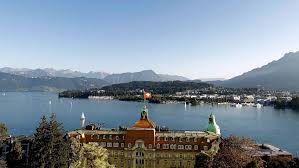
So I stand here at Tauck’s welcome evening reception in Lucerne. We watch our daughter eye the crowd, wondering if she would walk up to the teenagers in the group. Suddenly, a sweet young girl named Kendall, left her parents side and walked right up to our Bree, stuck out her hand, and formally introduced herself. They started talking, laughing, and expressing great joy that they had met one another. Their parents walked up and we all knew, rather quickly, that we would become friends. The girls just had to sit with one another at dinner that night. My outlook was being shaped by the obvious joy my kid was feeling one hour into the tour experience.
We had arrived in Zurich the previous afternoon. It was a typical Swiss arrival ceremony, which is to say there was no ceremony at all. All flowed easily, smoothly, no issues. Everyone in the airport seemed to actually know what they were doing and seemed to genuinely understand that their goal was efficiency. And so I notice my first big Swiss reveal in baggage claim. The bags are coming up out of the chute onto the carousel, as they do everywhere on earth. But here in Zurich, the baggage handlers down below have placed each piece of luggage on the chute so that the handles on every bag are facing the waiting passengers. Simple but emblematic of thoughtful planning and execution.
There are no required entry forms for Americans. The Swiss welcome us as long as we don’t overstay our welcome. In order to be able to reside in the country you would have to demonstrate to cantonal officials that you have the capacity to deposit sufficient funds in one of their banks to allow you to live your life in the country totally independent of the need for income and in the style of the Swiss. I didn’t qualify.
Tauck’s driver was waiting for the private transfer from the airport to Lucerne, where the tour began. Memo to Tauck: Advertise the private Mercedes transfers, an elegant and considerate inclusion after connecting flights.
Our room was not ready so we sat in the hotel’s street-level café as locals wandered in for small sandwiches, coffee, and conversation. We sat on a settee, center-stage, able to observe several dozens of conversational collisions and greetings. It turns out that one of the secrets of Swiss society is that every resident feels that every city is a small Swiss village. It is necessary for Swiss to follow the Schweizer Knigge, a sort of etiquette guide that dictates Swiss rules of hospitality. At work, for instance, you can walk the halls of USB and see employees who barely know one another greeting everyone they pass in the hallway. The word “Gruezi” is used to say hello to shopkeepers and strangers. If you pass someone on a ski lift you greet them, and you also acknowledge strangers on the streets and in the railroad station. I was greeted by every single Swiss citizen we passed on hiking trails, although might have been because they wanted to see if I was still breathing.
Getting city residents to conduct themselves as they would in a small village is a concept I will explore further. It has to be considered a significant accomplishment although the Swiuss never mention it.
In the café we noticed the Swiss constantly getting up from their coffee to walk over to other tables to say hello. You could tell they were not greeting friends – just people they may have seen before. And anytime the Swiss meet one another they shake hands. They are, I observed, the handshakingest people on earth.
It all starts in kindergarden when children are taught to shake their teacher’s hand at the start and end of each school day. In business meetings, everyone must be greeted with a handshake.
My theory is that the Swiss do not really engage in war because they insist on first shaking hands with any potential combatants.
The next day our tour would officially start. We walked Lucerne. The swans still pose along the edge of the lake that laps up against the city center. The city is wrapped around the inner lake like a well-heeled horseshoe. I noticed that many of the swans were fighting obesity and one or two looked like they could barely float.
I learned that one of the swans had to be put down recently. The lake is used for swimming and this swan would attempt to bite the swimmers.
As I walk along one of the main paths around the city I note that half of my fellow walkers are dressed in suits. They are headed for work. Later, they might change and go for a quick dip in the lake, or take a boat ride out to any one of a number of small islands for lunch.
What I remember most about Lucerne was a conversation I had with someone from the tourist board. I had asked why no one was fishing in the river that laps gently up against their spotless city.
There is no fishing, she explained, because there are no fish. Lucerne’s residents drink their lake water. It is too free of algae and chemicals to sustain fish. The fish have nothing to eat “so they don’t come here. Our water is too pure.”
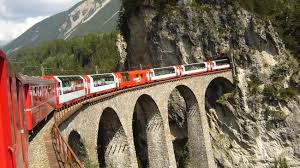
I measure trips by the number of pages I get to read before falling sleep. This has been a zero-pager.
On day three of our 8-day tour, we traveled on the famed Glacier Express from Andermatt to the town of St. Moritz, fulfilling a lifelong dream.
About mid-way through the trip on the mis-named “Express”, I realized that I really have a specific answer for those who sometimes ask “so what is your favorite place in the world?” This is it. The alpine meadows, the lakes surrounded by snow-capped mountains. These trains that reach impossible heights and go where no construction crew has gone before. After Rochester, Minnesota, the Alpine region of Europe is the most satisfying destination I’ve ever experienced.
I remember coming down from a Mt. Pilatus days earlier, in a cable car that is the world’s steepest. On the way back down from the mountaintop we hear a strange recording and I look for a speaker in the cable car, marveling at Swiss ingenuity. But I was wrong. This was no recording. We were passing cows and every cow in Switzerland wears a set of bells so they can be heard in the snow with low visibility.
The first half of the journey in the bright red first-class panorama car on the Express takes us from Andermatt’s small train station to Chur, the lowest point on its route. We initially climb with the help of giant cog wheels, incongruously passing a golf course surrounded by snow-capped peaks. We enter the Rhine gorge, that part of the landscape referred to as the Grand Canyon of Switzerland.
Then we climb again headed to the pedestrians-only center of Zermatt. It is cold and rainy, dark and dismal. But later that evening we join new friends and their daughter for a family dinner in a wonderful restaurant just across the street that serves a menu of stick-to-your ribs Swiss home cooking. We’re bundled up in sweaters. There is candlelight. The kids are deep in conversation. It is late June.
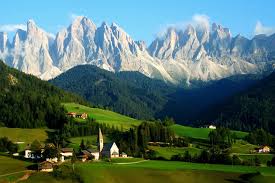
The next day we enter the Engadin Valley where kids and adults have a full day of mountain climbing. We take a cable car up to Diavolezza where, at 9,000 feet, we have incredible views of the Alps and the Monteratsch Glacier. I walk slowly up the steep walking path arriving where the kids and their instructors have gone ahead. There is a mountain stretching straight up to the sky. One of the kids has climbed to the top. With heart in my mouth I realize that the child is mine. She waves as she repels back down. What is that worth as a travel experience?
Later, there is lunch at an alpine cheesemaker workshop set in the middle of the woods just outside a small Village. The cheese is being made in front of us, the kids in our group are helping, the food is delicious, and, afterwards, the staff organizes a Swiss Olympic competition.
The next day we drive into Austria for a walk around idyllic Insbruck, the 15th Century capital of Emperor Maximilan’s Hapsburg Empire. After lunch, we go to the edge of the city for a personal tour of Innsbruck’s high-tech Begisel ski jump. The kids seem enthralled by the Olympic skiers who show them the course and describe their training methods. They don’t mention that once airborne, each skier has a perfect front and center view of the city’s cemetery just below. As a final gesture, all of the kids are invited up the skier’s cable car to the very top jumping off point, a location closed to the general public.
That evening, we’re off to a traditional mountain hut for a campy evening of Tyrolean food, music, and outdoor activities for kids. I did not think that an Austrian twosome ooom-pahpah band would go over as well as it did. But the beer was excellent, as were the sausages, and so, later in the evening the music sounded fine.
But our hut was special. It was right next to the border of Italy. In 1991, two German hikers were walking a seldom used path near our location. They found a body that they assumed must be a deceased mountain climber. They thought he looked like he had died several months earlier in a climbing accident.
The body was later transported to the medical examiner. Then archeologists were called in. The body nicknamed “Otzi” was preserved in the ice and on examination, turned out to be the oldest European mummy with a death date estimated to be around 3,359 B.C. Later, it was discovered that the body had actually been discovered 92.56 meters within Italian territory. The Italians have claimed him as their own. We toured a small museum and we heard the story near the site where it happened. The kids in our group were enthralled.
But there had been a problem with our itinerary. On the first day of the tour we were notified that our hotel in a charming Tyrol town would not be available to us. Instead, we would be staying at a place in Langenfeld called “The Aqua Dome.”
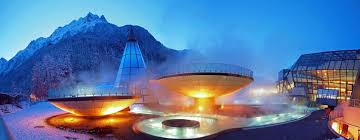
As we drove through the mountains to our substitute we were prepared for disappointment. The town of Langerfeld was Tyrolean perfect down to the required church steeple soaring up to greet the surrounding mountain tops. We passed through it, made two turns, and there was a huge, modern looking hotel that was really an alpine thermal resort. It was all stone, glass, and wood. There was a beautiful spa area and eleven pools of different types and temperatures. There was a brine pool with underwater music, huge domes you could swim to and then take steps up to enter. You find yourself sitting in the largest hot tub on earth facing the snow-capped mountains. There was a massage pool with light impressions and an entire building dedicated to aquatic facilities for children.
We loved it. My wife has been named the world’s top spa specialist by a major consumer travel magazine and she had never seen a wellness facility on this scale. It is owned by a Swiss company dedicated to wellness resorts called Vitality World.
The next morning, we decided to spend six hours taking “the waters” an unexpected pleasure in the alpine air.
The last evening of our stay at the Dome our tour guide, a masterful English woman who lived in the Tyrol, asked the group to gather before dinner in the lobby.
There was a handsome young man by her side. He introduced himself as the owner, with his parents, of the original hotel where we had been scheduled to stay. Then something happened, that was a first for me, and perhaps symbolic of the small quality touches of humanity one finds when touring with Tauck.
He apologized for not being to host us. It seemed entirely sincere. And he explained that he had signed a contract with Tauck but reconstruction and updating of his property hit a snag when they discovered antiquities during the building process. He said his entire family felt saddened by not being able to host us and he reached for a series of large envelopes. He wanted to invite all of us back to the Tyrol to enjoy a complimentary stay. But then he said something else:
“My family hopes you will think kindly of us and our wonderful part of the world so we would also like you to accept this with our apologies.”
Every family was handed an envelope with 500 Euros in cash.
The next time I have to deal with customer service at a hotel, an airline, or, say, Comcast, I will remember this kindness from the Hotel Klosterbrau in Seefield in Tirol, Austria. I will remember what “hospitality” really means in its truest sense.
